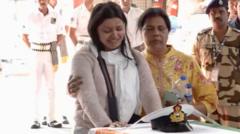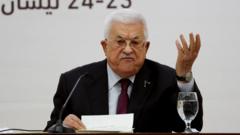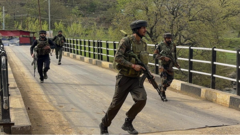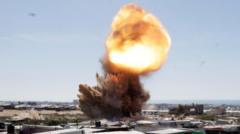As the war in Gaza continues, the health ministry reports over 51,200 deaths, sparking debate over the accuracy of these statistics. Israel claims the numbers have been manipulated, while Gazan officials assert their commitment to transparency and verification.
Gaza Health Ministry Addresses Death Toll Discrepancies Amid Ongoing Conflict
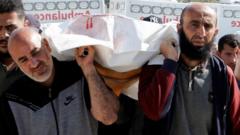
Gaza Health Ministry Addresses Death Toll Discrepancies Amid Ongoing Conflict
Conflicting reports arise as Gaza's health ministry defends its casualty figures in the face of skepticism.
Gaza's Hamas-run health ministry is under scrutiny as it reports that over 51,200 Palestinians have died since the escalation of conflict. A poignant scene unfolds at al-Shifa Hospital, where Alam Hirzallah mournfully registers the deaths of his cousin's family members, killed by an Israeli shell. He describes the painful process of obtaining death certificates while struggling to find burial sites as cemeteries remain under Israeli control.
The health ministry's casualty figures have been a point of contention, with Israel stating that the numbers are inflated as part of Hamas propaganda. Notably, nearly a third of the deceased are reported to be children, a statistic that has drawn attention from international agencies. However, the list provided by the health ministry does not differentiate between combatants and civilians, leading Israel to challenge the figures continually.
Recent news reports have called the reliability of these statistics into question, noting the removal of approximately 3,000 names from the official casualty lists during revisions. In response, Gazan health official Zaher al-Wahidi denied allegations of manipulation and explained that this process is part of a routine verification effort to ensure the reliability of data.
Prior to the current methods, fatalities were recorded based on bodies arriving at hospitals, which proved increasingly unreliable due to the chaos of war and attacks on medical facilities. With new online reporting forms introduced, families have also been able to report those who are missing or deceased. Despite this, the health ministry acknowledges that many deaths, particularly those of people under rubble or bodies yet to be identified, may not be included.
The verification process has also revealed that some individuals were incorrectly reported as deceased or had died from non-war-related causes. This has led to conflicting views on whether the adjustments signify manipulation or a necessary accuracy check. Some experts perceive these changes as a clean-up operation rather than an attempt to mislead.
As the casualty numbers continue to rise amid ongoing conflict, the situation remains dire, with significant challenges for both reporting and accountability. With international access to verify claims limited, independent and local journalists play a vital role in sharing information about the impacts of the war, while mournfully, families like the Hirzallahs endure their personal tragedies against the backdrop of escalating violence.
With no resolution in sight, the humanitarian crisis in Gaza deepens, complicating the complex narrative surrounding the ongoing war between Israel and Hamas.
The health ministry's casualty figures have been a point of contention, with Israel stating that the numbers are inflated as part of Hamas propaganda. Notably, nearly a third of the deceased are reported to be children, a statistic that has drawn attention from international agencies. However, the list provided by the health ministry does not differentiate between combatants and civilians, leading Israel to challenge the figures continually.
Recent news reports have called the reliability of these statistics into question, noting the removal of approximately 3,000 names from the official casualty lists during revisions. In response, Gazan health official Zaher al-Wahidi denied allegations of manipulation and explained that this process is part of a routine verification effort to ensure the reliability of data.
Prior to the current methods, fatalities were recorded based on bodies arriving at hospitals, which proved increasingly unreliable due to the chaos of war and attacks on medical facilities. With new online reporting forms introduced, families have also been able to report those who are missing or deceased. Despite this, the health ministry acknowledges that many deaths, particularly those of people under rubble or bodies yet to be identified, may not be included.
The verification process has also revealed that some individuals were incorrectly reported as deceased or had died from non-war-related causes. This has led to conflicting views on whether the adjustments signify manipulation or a necessary accuracy check. Some experts perceive these changes as a clean-up operation rather than an attempt to mislead.
As the casualty numbers continue to rise amid ongoing conflict, the situation remains dire, with significant challenges for both reporting and accountability. With international access to verify claims limited, independent and local journalists play a vital role in sharing information about the impacts of the war, while mournfully, families like the Hirzallahs endure their personal tragedies against the backdrop of escalating violence.
With no resolution in sight, the humanitarian crisis in Gaza deepens, complicating the complex narrative surrounding the ongoing war between Israel and Hamas.


